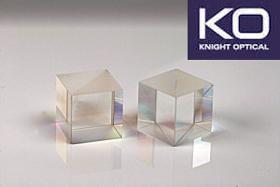- europages
- >
- COMPANIES - SUPPLIERS - SERVICE PROVIDERS
- >
- polarizer
Results for
Polarizer - Import export

KNIGHT OPTICAL (UK) LTD
United Kingdom
Knight Optical offer a range of Stock Polarisers that can be used in the visible range for use with cameras/photography. Linear Polarisation can be split into P-Polarised (Light where the electric field is Parallel to the plane of incidence) and S-Polarised (Light where the electric field is Perpendicular to the plane of incidence) light, where a polariser can be used to eliminate one plane of polarisation. This is done to decrease ‘glare’ (reflections on the surface) when an image is being taken, and increase the contrast. This is used often with cameras to obtain ‘better’ image quality at the expense of an image that appears slightly darker. Knight Optical also keep stock a UV and NIR range of sheet polarisers, for use with cameras outside of the typical visible range. These Linear Polarisers are available with single-sheet transmissions in the range of 22-44% and also in a range of sizes. Read PDF for more information
Request for a quote
KNIGHT OPTICAL (UK) LTD
United Kingdom
Knight Optical offer a complete range of Stock Polarisers for a range of applications that could be used for Head-mounted Displays. Our stock polarisers cover wavebands <0.2 to >2µm, we can also supply custom polariser options made to your complete custom specifications. A head-mounted display (abbreviated to HMD), is a display device worn on the head or part of a helmet that has a small display optic in front of one (monocular HMD) or both eyes (binocular HMD) and can be used in applications within gaming, aviation, engineering and medicine. There are also optical head-mounted display (OHMD) which is a wearable display that can reflect projected images and allows a user to see through it (often used in conjunction with a Beamsplitters). READ PDF FOR MORE INFORMATION
Request for a quote
KNIGHT OPTICAL (UK) LTD
United Kingdom
Knight Optical offer a range of Stock Polarisers that can be used in the study of insect vision. Insects exhibit sensitivity to linear polarised light. Insects polarise light in their vision for a number of reasons such as reducing glare and to increase contrast. This is also widespread practice in most modern cameras to help ensure the resulting image is as sharp as possible. Additionally, recently the study of insect vision has allowed researchers to modify camera systems incorporated in aerial drones to help fly independently through dense forests by assessing light intensity to avoid other objects. Knight Optical works with many leading research institutions in the field of insect vision. Knight Optical also keep stock a UV and NIR range of sheet polarisers. In particular our HNP’B replacement UV polariser which has excellent performance from 250-750nm is utilised heavily within the research of arthropod vision. Read PDF for more information
Request for a quote
KNIGHT OPTICAL (UK) LTD
United Kingdom
Within medicine the use of polarised light was first introduced back in the70’s; since then it has come leaps and bounds. How it has been used to help with imaging skin pathologies, when the skin is illuminated by linearly polarised light it causes backscattering of the superficial layers of the skin where cancer often arises. This superficial backscattered light can be distinguished from the diffused reflected light when using a detector. Polarised Beam-Splitter Cubes, Sheet Linear Polarisers, and Sheet Circular Polarisers are often used within detection devices for this type of skin pathology imaging. Knight Optical hold a large inventory of Polarisers for use within Skin Cancer Detection devices. •We stock large sheets up to 1270x480mm in some cases; we can cut these into special shapes at short notice. •Mounting options are also available. •Special Glass laminating to CAB polarisers •Special AR coatings. Read PDF for more information
Request for a quote
KNIGHT OPTICAL (UK) LTD
United Kingdom
Optical Sorting Systems are a widely utilized technology used within the food industry; most particularly used in processing harvested foods such as fruits and vegetables, most notably potatoes, and nuts. Optical sorting was designed to help improve product quality, maximize throughput and increase yields. Within an optical sorting system there are four main components, the feed system, the optical system, the image processing software and last the separation system. The optical system utilizes lights and sensors housed above and below the flow of the products being inspected. It works by using a combination of light and sensors to illuminate objects; and to do this Beam-Splitters are one of the optical components used. Within the camera used in the system a Beam-Splitter cube is used to divide the light source coming from a single lens, into different channels; and each channel is filtered to a specific spectral region Read PDF for more data
Request for a quoteDo you sell or make similar products?
Sign up to europages and have your products listed

KNIGHT OPTICAL (UK) LTD
United Kingdom
Precision grade plate beam splitters offer higher flatness and parallel specifications particularly useful in laser and imaging applications. Both faces of these precision beamsplitters are polished to a high degree of flatness of λ/4 and have excellent surface quality. Precision splitters are made from high quality optically polished BK7 with both surfaces controlled to a high degree of parallelism. Our stock ranges of precision beamsplitters are available for use in Visible, Near Infrared and Telecoms wavelengths with 50/50 split ratio. The beamsplitter coating is a high quality dielectric coating, the non-splitting face of the beamsplitter is multilayer antireflective coated to eliminate second face ghosting effects. For more information read the PDF
Request for a quoteResults for
Polarizer - Import exportNumber of results
7 ProductsCountries
Company type